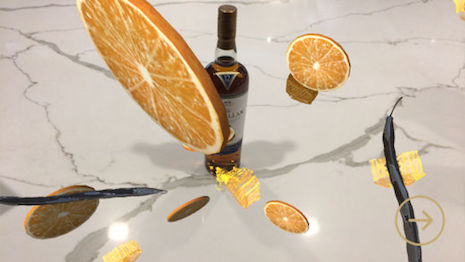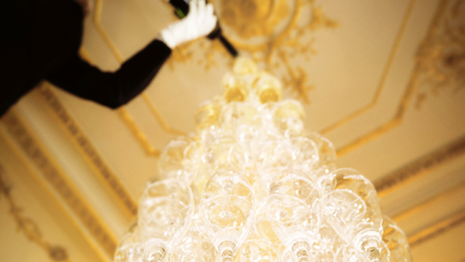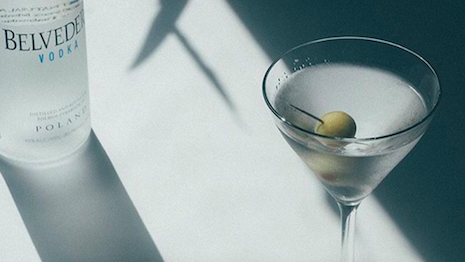While overall vodka sales are down internationally, even in the traditionally vodka-loving region of Eastern Europe, the most expensive super-premium segment of the spirit was actually the one that experienced a remarkable 15 percent growth, according to a new report from the International Wine and Spirits Record.
For luxury-level spirit enthusiasts, whisky and scotch are typically the most sought-after drinks and the ones whose bottles routinely fetch the highest price. Yet as vodka sales are down in every other segment, the growth in the most expensive types of vodka, those consumed by affluent customers, shows that the spirit can still be a contender in the luxury beverage market.
Vodka enthusiasm
The luxury spirit market has seen healthy growth over the past few years, with sales of whisky and scotch remaining strong and some bottles fetching record-breaking prices at auction.
But one category of spirit is often overlooked in the scheme of affluent beverage consumption: vodka.
Traditional tastes favor wine and scotch, but a new report from the IWSR shows that ultra-high-end vodka is in a healthy place.
Overall vodka sales fell 3.4 percent in 2016 and recovered only slightly in 2017. Key markets such as Russia and other parts of Eastern Europe have all slowed their vodka consumption by as much as 3 percent, as has the valuable U.S. market.

The Macallan tasting notes with the AR app. Image credit: The Macallan
Overall vodka sales have dropped an average of about 1.3 percent from 2012 to 2016.
But the silver lining here is that IWSR found that the most expensive segment of vodka, made up of brands such as Ciroc and LVMH-owned Belvedere, had surprisingly strong growth last year. In 2017, sales of these high-end vodkas rose by 15 percent, compared to a mere 2 percent for vodka overall, with almost 900,000 cases sold in Europe.
Spirit landscape
Vodka is certainly still an underdog when it comes to wealthy consumers’ tastes. Spirits such as Champagne are still on top in most of the most lucrative markets.
France is estimated to consume 102.2 million liters of Champagne in 2021, but such little geographic diversification can be harmful to the economy of the sparkling wine industry, according to Euromonitor.
Understandably as Champagne’s country of origin, France’s forecasted total volume consumption greatly outpaces its European and Western peers. Unlike other spirits such as Scotch whiskies, Champagne has not yet witnessed a high boom of interest from emerging markets (see story).

France consumers the most Champagne. Image credit Moët & Chandon
Other categories such as whisky and scotch are where many brands create ambitious marketing campaigns to capture the attention of ultra-wealthy consumers. For example, Scottish distiller The Macallan developed an immersive augmented reality application to educate consumers on the differences between two distinct whiskies.
By using The Macallan AR app, consumers will learn what differentiates the distiller’s Sherry Oak 12 Years Old and the Double Cask 12 Years Old, an experience likely to be enjoyed by both experienced and novice Scotch enthusiasts. Augmented reality’s use has been explored in a variety of industry sectors, most often as a teaching tool that heightens experience through interaction (see story).
Vodka is not the only category to be facing trouble, however. Crisis zones and economic uncertainty in the Caribbean have had a deleterious effect on the spirits market in the region, leading to falling revenue across most categories of high-end spirits and trouble for the brands who do business there.
According to IWSR, sales of high-end spirits have dropped over much of the region due to economic tension and repeated disasters. Meanwhile in Mexico, the overall market seems to be looking up (see story).
But as the data shows, high-end vodka seems to be undergoing a bit of a renaissance. If expensive vodka brands can capitalize on this new enthusiasm, they may be able to enter the luxury realm usually reserved for scotch and Champagne.
{"ct":"GummbuFFre6uUyXj5cUkiWI8xPBpI\/t9drdx\/owXrqxUt\/uhq\/Z526jxX8fHB6Vch98uEASjPa6\/tHPrytgburIHH4aRCSi56Lf4BJl4MlSBITj7d\/7aXIdmjm0f5\/mvS8J8NK06TBoOBvUk+kLLcJ43u7NlZy81o2YAqLJe4fna49u38yTlRLWQf5WWRZuTs2El+0DJ2ucOKQtNCfYUMP6kpjtkG3ox4LjdagxWT\/F6t35skBv1F6UKQLHxzdsKRRRLxAgN2BqxpImG3DwJ8Q0OOafD42Atl3cIP0eXS6\/I+ABd8DlvXNeMj2wN30XuGgTrbQhsvp+Evo1UnbC\/ywMkwGd\/1f0LCTDDPjhMJkjwzaPJPl6gEe8HyxFG\/hGkpuZ51eVOsaJifrp11GSJvuQG9jR8xaIx5Fk8cF7Yw5KHA8\/f\/RDDS5UI8PGJg78oNA9IOJM5Q6+JBesgJlP9nchZiH7WDIcAn2SnukfrfggegCcb9USIBlbSgrnUYJLVlezK5RJlo\/yYQCmlMB4aqKJJpdmyDtl\/SGng5V881XH3cECjv778z31GLOZUWZ52xwqptCOwmByRDvh9S6NHq1cuDanlI\/F4bpFsJjZe5z5B2BWfjhgMxFbPHObAZp\/owPQuIURYF7zs\/BaEWCwgQR7Vp82p0VxkQB3jEE6PIdydKBgtq8m6J7jaPVsNRFWMdqjXhu4cuQ9gQg20HXQgnNQZeRoqfCiBhnivJk\/qErosdMMmI9yfFnF0M9MjZLtu\/sFUzCKBoQzkP7nteeVOu1nymuIiPE\/hFPjaumcehgWfApiwxVcmRvCnp7sHj1Km4EdZddPZvXDvm7O1w6jz3df9C9Z8\/udhY7+YTJkCyWJlis\/Ml\/QYSTGcXhzvDZ3urBdYLw6Ub154KeuxwrJCAzZ\/LYByloEMaKSgzCfkl21PegaQtZVZZzoY9uUwyJGNvbTEqlEJjdBdVW3S2eOXfQlTsotANEYXc4bJn5QH\/3yhaziJmP35uLHxibMEyyb\/hWgWWbtTjt84BfbwexYvR1BC++3ZhzbgUseyOUBOapSsq0ZKJBuLtnA5eKSEzXdU6qhdpVrazJSi4iqgCWi9yjFZ9x2f0SvmNMlHwbCakf4yAjwDhvl1zgefm1ci1xPmSvMHlGGUIEOuNSuGuYi9r\/1M9SUX8XSSfm+MaWwf2XUPvlV1fDl8nGarkmnJJ8eD\/yWnUbJwX+3+rgBKJ+hzz6pkECe6iFjY0KjyVKJNWEJhHTTcUsQ919pL0EwGEUT+Z9xLnP7k1pmWp7PmrgCVZiobvpmTFHGhpUJOClvm\/ZYIlW6s4lEa81tkNSfSCvhSn1RDa3x5sDtH7E+GA5gvqAHqiWlE+StC6xc+rtieo2mYJCqOMEUQFuka+9U7YjBFqMMzHRdwdAdrseoUMRYosFv6CAz8lzyM8ZD8OjqShafnyiMX3P2hH0mOBNaI3+M+cT1VLxqw03BZq\/7zooo5SasX5YL1jt2c88a+SlzVRMzmolaRK78bYzBjPWPeg2y1eagXiD5FKaroBSitv6avit1mDKWFDjPkmXcJDVjXNO4OVI55NWwfqQKIgSCRsGJJqJhYUVklUNRIvbJNKWFo3wHcA7nsZkL1M3iePluwY51mrKzGh3K3gLRY41Po\/xNnsbmwfQ7Qmx30AL3ovrqQ7rzs30g5Bb+vxA0PUkGQJ3saka\/pcfgcfPbOlVfWR8g7Mo92Hbf9k3YaLoYaGu64\/0z3xczLiN8CV6wLnY4R8M8CzY+0GJ2BDgQ2CZXbYLjMXixQkOqr2cipmOCgKCjoGJOLhb4eKkqBZXLEgWhuhbcxzg45PDQHlJ\/B+ec82izB+TCY0xMH57EY\/BeX7pwhqJEIADD6uU0PRhjzCh8sGtrp9Po+pAvOG\/2peopy17wEWo1kxFct315GhfyrtAzBMMUoJjNHrYutYhTgZBeTm5uMeb25EB7\/QgsFre43oITrO0meCV5HFIi11lkmhDjZT3QIjIhb3sJ9WFNFT0W9iw8qhOun+zkSCyq5R7v8ISxy4yubzDn170Op+ym2qB7bU2oA6mSjS1ZjMGFAnQ4ZU++5LPqGDgAVA5chc0cyj0lCsHH36qLZBYvT5hgSyluz2nV8LVdq9gQ8oNCymhA8WgyYo1S+j5vDpIPEcsz6801STMaI7fLbvunSqDIBBd+ryhSxFL0lmBbOg5GPRuzAvXHpp6g+PjtoV5D8zHLp4BGenRZZbz8U5hZd4qBzo5VtCIHd7B7P6piC5x2JNC1VevAFAorxR0GcZiQIByTQko3x5TK7lTpuTNJQbz7Z4e9nFCG9\/7huDpef8rv5sTQiUv6x+g+fgmqhjOTUSVfIYdqN93k+AyRYW8DZFj0f4MCupdex2NlLPLtDtqZCtauDlZHsnYkHdOAlklYa22229V9NALH8Hu4QIHZ+AjEZROUpXE5ChOIYMBEHztziGjsDvcCCpWfn02Wav9YBAUkuRryWSjz3yYeTBzlSKIWbJOTdA\/37rfZGPx7J8tPo6tnG6Y2xKva\/uVksG1XmLNn2bB6Sp8\/MdOoBb6pZKrEvfr5A8c\/C\/TS6oo+o75qu5Xump6HNUCWMMZLD2QEoghzlFgAxF1TrPsusSyPPByHPKQCKfRIIYoZm0dX7T1jvereXfn5Opt41dymfE187pZ3+R2mUNg62GlPKhhuu1\/vSSzux\/ukYjb8ztzLGd+fAo1+gE3qg8olir6Bkr6PQFpOfy7vSQh0eHiLW1ning9gk7gjF99LjMrOLi6urUo2pJlrwxi1LAV24LQDdVuZP\/fy73Bha0ge8uB7dBC9wxETsQrJZPOGmA35PgCZJZW4ulfiWz5G2wND4MIKkfEMglkRdjLV7ImF0HrcadY4OhHUWJ81eidKJMVqgzsaQPXhRNdRnk5QdmrJT1myk07l\/QeFqMAq4PWlncv4tJdmSCMGmbCIL7bpc+m06uMQIZhKxt1MToX7+bXNHGjJi6VT0QOqWiFn+yhwnwuOr+QgYKxZeMVc79gpLQ7XH8Lgizxl+mgkogbb0oKnYga5gS4rRFuut2tJaoaR6085rJx9XsU1KrRSR4agqVLjyaHC7cu2tYQPOkApIbsx8CgtImCSgKZv0VyxokSuQWpCulX9oVTkaXcBOwteh6JMteLWlIFeYCKD9FdvaOYghEiinH\/GSnAkp6A0krA7gdmWixg\/SWhBEW8X73GUHaOGLSBE359Jja9AfNqkb1lWv8V3jCxuogbLjhew2UvrQHZOW1CD\/5iE3KUpJX7A1jA+8Nv5e22j1h+rsqA6pqOXtpX\/6vKx4T3cOIhQtDgs93gvQE8NeT4MNJ8xqCvxoOcuMoo9Hz5E50x\/04tczC\/zoFadUn3gdaj5ckEAAjwBYnD7Ivx\/E39WqBiGJ7SKOZG\/S1gyGHmGNL4oJNhrmPR3t8EIygJ53DWVgqRVvB3rQqMoJv1wwn27XNrumMH8iCSwu4YPUUnyfQ+He4tq2LW3S9EsZ2Uhnucjnb3OklszffXiEAelkXoxMF1MVVUEAKVMI\/jN3eRwl0fGW5NzJxmW3vF3Z8XZxDr9pjPSCewn8p1OGHsuSgs18jhxawvHzwkNQu9lbjrEbbLGlZSmwfbJMNHd3u3+bM77TUjscwh13Rhb6n8LW5Bv6qgBkHrhqyFWTIZHuQ50PPyYWXA6Rx4qGYLqYIOBLpDu5L6dgSoXOrbM0WuQzYUjmh8AJexo2t3rOhzM7\/59PPlXORR8\/DQJvJ73JwTy9O02Yc+fGgd0ev6P9n5SYtNoAyWQ5PoXFJIKSnttPHMO9S3G098wajUZGVkN2dVSjXeeuih0gfzm1p3bZz2\/X9cDgQFNJUXFykRu1rEiRsWhfxf5JvIgpdpa6RrZoex7qbU4cPow1E5pHzX3TBeHpX9rl1fNQrb7tE39CiaR\/6PggDVWW4+CsDdGAvhAtTDABjJkgJtbpcIYJIcvNg2cA6MKnbB3qch+llurE\/9hZKSJ+GFe1t+ZmXb6nr+Px716OpYRMuE9pSnkuU4Uq41GCkFvKwxshVUPbyng5A\/7orXVg60Ch0godm6a7ldxydG2HgJ7k\/3jTw71GcKqHH32mYPeX7R0YG6ANDF7At2G8kNwEyYzvRBk1nrk\/sAtQg0uKdELEDokv\/KHUHuX1EHQ24CXHQ45ZnfMM0zbZbRqv6SINDsOrZeCx2m+6kZk1l6g+ulq0kNXGSqKd5Ibx3gsU96e+H7Y8pK2BvcFkSIEwOZTgc0uKyd2ctuYQBPLHayEZTbutzZFEnZenP9nKHLrLun1J5ZVoWR4j+pXbkuEOywtxxHM6TyhugPMcBwfBbDyE1Tz0U27aRGrz98ATzd5TMdD2lyUbZfkkG1z3gOpsq\/5cJv3DRGR8Or1\/fmF4KV8wd8F8v\/U5l0DUbzjhlQpdIn\/OaAYR2l8ZzLIpzee52VCWvCmlMkEu7RcX9Zxy4UJWNCHpyHb3H6drfY4OVbc9+hqsSNcTRJUk7\/ro7pZgQigQn5u\/rjH\/GSk6yEFgCqw7+MGI+gfQCZfcrfOhbmDZTPrbo1QnufyK7jVyk\/LlwqQoTd2k7udvLVbgUXid7LahdPPk1zbDByo1j+FBADeppu2QloOTCJv5z3Z95VLJOLSGOqUzv7ss3l\/2asTiPRjMlZWGCOK6OENt\/jqHu43hJOTt56T0dr\/5tHr2dcWsrAft+jChMys7qQ\/\/j3TeGokhGYA4lAJqAiNRSS4UOadpcGkCf7O+WHzSUymwWVqzivFBLAG4lBrTeBqHgp\/0Wyu4MlZDTTgNndBCHaI2yqJ6527An1ahykPd5jU+LEmB6vzw2oV17VNvDAz+fzr2Dc+okeH7Gtd0Y8o0pwwHArJpNUASkoVe8vXTbDg790S8W1gvQ1rnTkznGOxy5S\/KyhXRwwQHu5KTZDT1u6h59OM6A+640VNfJd301lehownE62QF+ifZibsPX3gkqTRHYhIvCXTFGBLhJ\/KBd0q55zKYvCaQm0i3KQE7gGlrkX4g8UP6daKCJL6+ugK4BxbgHX4nF1Rp4pHmRPR5gVIOdTqkGCCFKLx6r6949xBSwe4a6WGqkJZF5ZUiqZUYfNMWZzs1uQTRjLQVg8kgZ9euvBrgYxrc5HCz56Z0r3a+n3oGE8PR2cOEedCrfHuDAUoNX\/lKuFcbMYVefF75DPvSzQSGPFtcChQzjP\/vQGsSWWeR4WX44KG3XmPqu47YjmCfp\/oZ8yJbZBHEtFUE0C46LFAX+qNNbfFWr9Q4wQzL4hafPLEzgAx0GcBKLliLfPOZ9xRV+tG5k0vcQIpJBI9Rn2soVEPIM7n70FTMM5YAxu2w2iWlVU72+k3IRTy8tKbGBu45gE3vXZumn7JopK0aZhC5w45+gboiENMxuTZv622ezcOjR8s7avfTyzxEV9O\/PYxrA+OaU6zoUuCRoqxqMfS12J0q6PVr8d26BMUvFEMIMMoDDIUNmEWbn0k+quNrrY\/qyAw1MBoP6ZedVtLmfWo2eq+vkmiI2UFXwd26qw2Euhai2R63CiCxW8g7O6SAsIsAi5rISseaSgneLPaG+0X5gEN+vZtIdOlV1wC1H0ETU6pI7qWlYwh1QWRKvnIT5tAH9fEl9\/msbdkYlK8EbjwMNigfiPSo11MCNvCetnzBi5rVGJq\/0\/wUMmA3iIxRsRSc4T5LJukI41SumIpm0P4W\/rSFsKN0Z+9bQU4Sbi7W3ZabW5kZudGWcvQhAlJG6R6Q0LynD2s0MmgK7U2eSV4EpSJQNExYR8jDiM363gOXfCoT96SRg7xL5VxxlXgR2wC8b00huTIam9gCvoPOiPlXswt7zujHosj3Ln0C93dXZxU9dDd8YG+MekkbvtZgyhb4iAVLYxB0OeeFqZA33oqYzo7UUOP7HeCkVUrhBlNqqTCBt9DiLvhzl9lrJbkkvr\/dgVo6JUrXeqdUa26QTNL6MahK1Dlvn67wKGmKAHAT+7T3rG9BHwXY+1Vi+dLuoeyDjJMqv8SE2gCl39cgwwbsIwtwrjh2GZN8Y4WLfL8dtr1u+7w0DtMfxfui8AzEECBxP+oFUzlCGzCTg86vb31IojLCvaZVJIPF4cpYpdcGl9MJudO6nTjSG9TRy7uygsgF5y8WQvWRIY0AIOL+GO0z7jajaQPZXOGFHR9CZg7BJdpSmS2p3mlzKpPct\/p5IghhFL3QRo11u3wgPr+mrfYGLbzH20U1aTrxVEn4nFjuJEgrWD61qtTn3Doz5mYrgFi7pr5CXMxL+RiYl3apH70AucZEpaSrScSQIgZi0m7tT0La3qMLtiLXVIpp+LTlXGiS+fZc+OKr35sfRqImA068TTSNVvZoD\/2iJ4utwinjCP5HINVSEwtl+hou9dbXOqJC7g+yIEemtcvNpxlPuQBis7PkEorUdGpVXl66xun2H2JMNLp5KEW60GewuhvwW4cj1iYkxU507wP75BGIyvT8PhjlDTOP1tJxqXwzLKu37pzMdsuaECu2bpfZuhSoTE90THolgOf+H8slmyKloQF\/sJ3AiV36Oxi7+P5vr4Oy9F0NK4SJgVQB8DphZO0p3KlABtFtzGf5HaERwM8Sh5EwF3MAS86eIiH4MdrR0++i5XzDvBZZnCswHgXRib20vhWlAZiuMlUKgmq1L4a3IdsRjf3WLM757COxlVJuG43KtVDNIGMfxNYrutZPFR\/ojqn4PXGbBG3UWu5f\/5U8NzBiLZJMDOTiCfDiYief9g0M+ixJZjt38CB++KR7lKG+u595Any6uTG0Tr\/oufrJNDiSNdWjnVEBmqQPqedCLS6fRqTJessUaGtmjDRT4oc+kvT4+SmXXKPxZ5lzKhTFX9WFtHQaGbiQ8tBmS\/voynFGvpEpfpAtAUQwlKTxqMEZLKFKsCi5lGpNxBooZJcetutnCkJRNg7HeENkZwB7cVgmcIP74kozawyVvJhUZr5fq\/fpialz8SJESVeijRh5HoDVsKThyvjqbqBcHAOBYrsr784cGKz1nI55gTiKhalrFQ+GTVzRUx7oAg0J6ljuDRO7Ih1crKFVJ3p1KwYf9f79VsqiEooG1kP53xyH\/n6ukLuv3TIu4s\/ERwN0naCE4CG+cKE+F+oNTg0WoA3QIHc8xuRw4XnwUu5o7ZGmwDFhWSOss1LGZvPSkk+ByOCSgqJtx3Qf7gPsYhoHG+9wq2b5NqFIt3V999b5RVDeA6RkvRN8FGtZnn3MYmQoglKo9p+Kb1tkIp2aEd67P1zFJCFOSyS6MN70fcYnnwbEZ+F9a6BpwAMHzZ71JQqJY6Q\/okyzGW+pE4WsxA==","iv":"9d0d374ccb8968b6636bcc9b1d1596d3","s":"7b5813df0044c1e3"}

 Vodka is not traditionally competitive with other spirits on a luxury level, but that may change. Image credit: Belvedere
Vodka is not traditionally competitive with other spirits on a luxury level, but that may change. Image credit: Belvedere